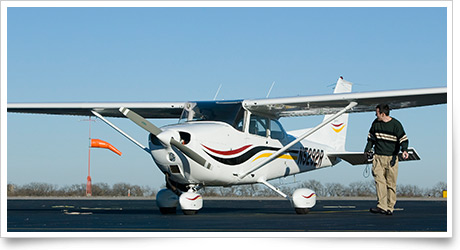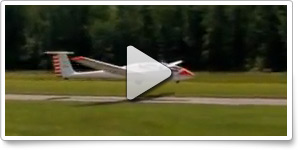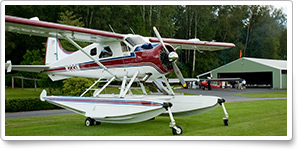| ||||||
| A quick turn |
| |||||
Training TipsA quick turn Even for this short stay, tie down the trainer, chock the wheels, and install control-wheel or gust locks before you head inside for a snack, to close your outbound VFR flight plan, and to update weather. Take time to review how you will activate the return flight plan. Will you contact a flight service station via a remote communications outlet (RCO)? Perhaps you’ll make radio contact on 122.1 MHz and listen on a voice-capable VOR. (Remember to turn up the volume on the nav frequency on which the FSS specialist will respond.) It’s good practice to remain with the aircraft to supervise the refueling—everything from the type and quantity of fuel to the handling of the aircraft by the crew—but that’s not always possible if there’s a wait in store. So be sure to perform a proper preflight inspection on your return to the aircraft. Take a fuel sample, visually checking the fuel and oil levels, and check the security of fuel tank caps. Don’t forget to remove that gust lock! Lapses have happened, and have sometimes attracted official attention. If delays are inevitable, avoid letting any imagined pressure lead you into a state of “get-home-itis,” described in the May 4 Training Tip. Giving in by making a hasty getaway could cause you to skip a weather update or pass on refueling—bad ideas indeed. Failing to perform thorough pre-takeoff checks doesn’t save much time, and it could cause you to miss a first alert to a mechanical problem. A much better strategy for arranging economical use of your ground time is to contact the destination FBO when inbound, giving an estimate of your time of arrival and stating your service needs. If you are receiving radar flight following, continue monitoring your assigned frequency, or, if that’s not possible, request ATC’s permission to leave the frequency briefly. A quick turn doesn’t mean a mad rush. Speeding you safely on your way is everyone’s goal. Tell people your needs, and they will deliver. Flight Training NewsTougher, brighter stock coming to FAA chartsThe FAA is upgrading the paper it uses to produce paper VFR charts. Starting May 31, you can expect to see FAA sectionals, terminal area charts, and world aeronautical charts printed on more durable, tear- and water-resistant stock. Read more >> Girls With Wings accepting scholarship applicationsGirls With Wings, a nonprofit organization aimed at getting girls interested in aviation, is accepting applications for two scholarships. The Private Pilot Scholarship will award $1,000 to a female who has soloed but not completed a private pilot course. The Dreams Take Flight Scholarship will award $500 to a female who plans a career in aviation and would benefit from experiencing introductory flight training. The deadline to apply is June 30. See the website for applications and essay requirements. Able Flight picks six for trainingAble Flight has chosen six scholarship recipients to be trained for a sport pilot certificate this year through a partnership with Purdue University. The six trainees will live in university housing and receive flight instruction from Purdue CFIs. The students will fly specially adapted aircraft provided by Hansen Air Group of Atlanta and Philly Sport Pilot of Wilmington, Del. This is the third year for the Able Flight-Purdue partnership, which seeks to provide flight instruction for people with disabilities. The program began in 2010 with two students. St. Cloud State closing aviation programSt. Cloud State University in St. Cloud, Minn., has shuttered its aviation program, one of 32 slated for elimination in a cost-cutting initiative. The program will officially close in 2014 so as to permit the approximately 150 students currently enrolled to complete their training. St. Cloud’s program had been under consideration for closure since 2010. ADM and Swiss cheeseAnticipate, recognize, act, and evaluate: These four concepts are key in good decision making and at the core of the Air Safety Institute’s online course Do the Right Thing: Decision Making for Pilots. Become a critical thinker and stave off accident hazards that line up in the form of fatigue, passenger pressure, stronger-than-anticipated headwinds, or miscommunication. What’s this got to do with Swiss cheese? Find out when you take the course. Training ResourcesAfter you preflight yourself and get the weather, do you just hop in the airplane and go? Of course not. Proper aircraft preflight is one of the most important things you do as a pilot. You’ll be amazed how quickly a bird can build a nest overnight and foul your plans. Bugs or other critters may find themselves a nice cozy spot in a pitot tube or under the cowling to spend the night. See how well you prepare with the Air Safety Institute’s Aircraft Preflight quiz.
Did you know that student pilots who join AOPA are three times more likely to complete their flight training? Membership includes unlimited access to aviation information by phone (800/USA-AOPA, weekdays from 8:30 a.m. to 6 p.m. Eastern time) or from Flight Training Online or AOPA Online. If you’re not already a member, join today and get the pilot’s edge. Login information is available online. Challenge: Powerless flight Career PilotAOPA voices concerns about proposed ATP requirementAOPA spoke out against proposed rules that would require airline first officers to hold airline transport pilot certificates. AOPA and other industry groups took issue with the proposal, which they maintain would force many would-be pilots to abandon aviation careers and exacerbate the shortages that threaten the future of general aviation and commercial air travel. Read more >> Delta to purchase refinery complexIn an effort to reduce fuel costs, Delta Air Lines said April 30 that its wholly owned subsidiary, Monroe Energy LLC, has reached an agreement with Phillips 66 to acquire the Trainer refinery complex south of Philadelphia. The acquisition includes pipelines and transportation assets that will deliver jet fuel to Delta’s operations throughout the Northeast, including its hubs at LaGuardia and JFK. Production at the refinery, combined with multiyear agreements to exchange gasoline, diesel, and other refined products from the refinery for jet fuel, will provide 80 percent of Delta’s jet fuel needs in the United States. Plane Spotterde Havilland Beaver: Beefy hauler Training ProductsOnline flight instructor refresher clinic from King SchoolsFlight instructors have another option when it’s time to renew a CFI certificate. King Schools has unveiled its new flight instructor refresher clinic, which claims to move away from the same topics that CFIs learned as private pilots and instead focuses on such issues as identifying and changing at-risk behaviors and conducting an effective flight review. The course incorporates a paperless online renewal process so that instructors can receive a temporary certificate by email. It is compatible with the iPad and all Windows and Mac Web browsers. The cost is $99 without CFI renewal processing or $124.95 with processing included. See the website or call 800/854-1001. Note: Products listed have not been evaluated by ePilot editors unless otherwise noted. AOPA assumes no responsibility for products or services listed or for claims or actions by manufacturers or vendors. Member BenefitsFive situations where your AME can make the callDr. Warren Silberman, former manager of the FAA’s aerospace medical certification division, explains the five conditions an aviation medical examiner doesn’t have to defer to the FAA prior to granting medical certification. Read more >> What does an aircraft insurance policy do?If you’re shopping for insurance and are wondering what the difference is between hull damage and liability, read on to learn much more. BlogsSavor the momentIn this week’s Flight Training blog, Technical Editor Jill W. Tallman says there are things she will and will not say to a soloing student pilot. Also, professional pilot Chip Wright observes the transformation that takes place when a pilot assumes the responsibility of an FAA designee. Stalls, spins, and misunderstandingsSteve Tupper explains why the nonflying public often becomes confused about the term “stall” when it comes to airplanes, and delves into the aerodynamics of airfoils and angle of attack, in the Let’s Go Flying blog. AOPA Career OpportunitiesEver dream of turning your passion for aviation into a career? We’re looking for a vice president of information systems; human resources generalist; insurance services administrative coordinator; registration, housing, and meeting planner; vice president–Center to Advance the Pilot Community; aviation technical writer; vice president of strategy and philanthropic operations; program manager–products; project manager of online products; director of new market development; and associate editor–Web/ ePilot. To learn more about other AOPA career opportunities, visit AOPA Online. Community
AVIATION EVENTS & WEATHER
| ||||||||||||||||||||||||||||||||||||




 The wind is blowing smartly as you land at your cross-country destination, where you will take a break, refuel, and then depart for home. You encountered strong headwinds aloft, so now it will be helpful if the line crew would perform a
The wind is blowing smartly as you land at your cross-country destination, where you will take a break, refuel, and then depart for home. You encountered strong headwinds aloft, so now it will be helpful if the line crew would perform a 





